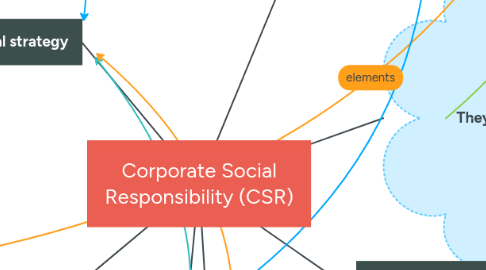
1. Corporate social strategy
1.1. Market opportunities
1.2. Resources
1.3. Corporate values
1.4. Structure of
1.5. industry
1.6. Concerned parties
1.7. CSR alignment with the main business
1.8. Social impact of the corporation
1.9. Responsible behavior of its suppliers
1.10. Zadek (2005)
1.10.1. First generation companies: Short-term pain relief strategy.
1.10.2. Second generation companies: Establish strategic planning and risk management policies.
1.10.3. Third generation companies: They incorporate the concept of social responsibility in their strategy.
1.11. Husted y Allen (2001)
1.11.1. Industry structure (Porter, 1986)
1.11.2. Internal resources of the company (Barney, 1991)
1.11.3. Ideologies and corporate values
1.11.4. Relationship with stakeholders
2. Competitive advantage
2.1. Companies use it to take into account social and environmental impacts
3. Reputation
3.1. Logsdon y Wood (2002)
3.1.1. It can produce better results for the company
4. They involve social and economic consequences
5. They influence and are influenced by
5.1. Opportunities
5.2. Resources
5.3. Skills
5.4. Corporations
5.5. Industry structure
5.6. Stakeholders
6. Strategic management
6.1. Husted y Salazar (2006)
6.1.1. Add value
6.1.2. Get competitive advantage
6.2. Halme, Roome y Dobers, 2009
6.2.1. Companies care more about social responsibility.
6.3. Coutinho y Macedo-Soares, 2002
6.3.1. The strategic implications must be associated with business strategies in the company to be efficient
6.4. Andrews (1987)
6.4.1. Market opportunities
6.4.2. Corporate resources and skills
6.4.3. Values and aspirations
6.4.4. Knowledge of the obligations with the company and the shareholders
6.5. Molteni (2006)
6.5.1. It helps to find corporate management to innovative solutions based on stakeholder expectations
6.6. Porter y Kramer (2006)
6.6.1. The activities of a company have a direct impact on the communities with which they work.
6.6.1.1. Positive consequences
6.6.1.2. Negative consequences
6.6.2. Social problems
6.6.2.1. Generic social problems
6.6.2.1.1. Important for society
6.6.2.1.2. It does not affect the company
6.6.2.2. Social impact of the value chain
6.6.2.2.1. It affects the company's activities in business
6.6.2.3. Social dimension of the competitive context
6.6.2.3.1. Significantly affects the direction and competitiveness of the company in the place where it operates
7. CASE STUDY: CARREFOUR
7.1. Competitive advantage
7.1.1. Employee Motivation
7.1.2. Image enhancement
7.1.3. Best reputation
7.1.4. Awards
